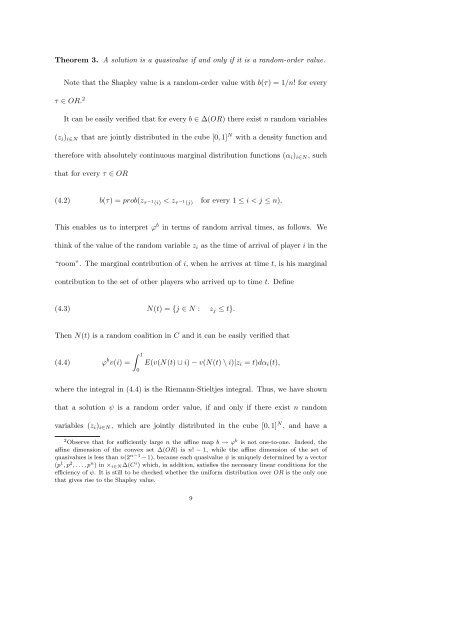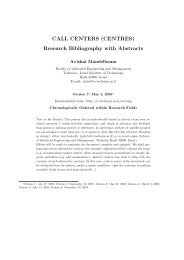Variations on the Shapley value
Variations on the Shapley value
Variations on the Shapley value
Create successful ePaper yourself
Turn your PDF publications into a flip-book with our unique Google optimized e-Paper software.
Theorem 3. A soluti<strong>on</strong> is a quasi<strong>value</strong> if and <strong>on</strong>ly if it is a random-order <strong>value</strong>.<br />
Note that <strong>the</strong> <strong>Shapley</strong> <strong>value</strong> is a random-order <strong>value</strong> with b(τ) = 1/n! for every<br />
τ ∈ OR. 2<br />
It can be easily verified that for every b ∈ ∆(OR) <strong>the</strong>re exist n random variables<br />
(zi)i∈N that are jointly distributed in <strong>the</strong> cube [0, 1] N with a density functi<strong>on</strong> and<br />
<strong>the</strong>refore with absolutely c<strong>on</strong>tinuous marginal distributi<strong>on</strong> functi<strong>on</strong>s (αi)i∈N, such<br />
that for every τ ∈ OR<br />
(4.2) b(τ) = prob(z τ −1 (i) < z τ −1 (j) for every 1 ≤ i < j ≤ n).<br />
This enables us to interpret ϕ b in terms of random arrival times, as follows. We<br />
think of <strong>the</strong> <strong>value</strong> of <strong>the</strong> random variable zi as <strong>the</strong> time of arrival of player i in <strong>the</strong><br />
“room”. The marginal c<strong>on</strong>tributi<strong>on</strong> of i, when he arrives at time t, is his marginal<br />
c<strong>on</strong>tributi<strong>on</strong> to <strong>the</strong> set of o<strong>the</strong>r players who arrived up to time t. Define<br />
(4.3) N(t) = {j ∈ N : zj ≤ t}.<br />
Then N(t) is a random coaliti<strong>on</strong> in C and it can be easily verified that<br />
(4.4) ϕ b v(i) =<br />
1<br />
0<br />
E(v(N(t) ∪ i) − v(N(t) \ i)|zi = t)dαi(t),<br />
where <strong>the</strong> integral in (4.4) is <strong>the</strong> Riemann-Stieltjes integral. Thus, we have shown<br />
that a soluti<strong>on</strong> ψ is a random order <strong>value</strong>, if and <strong>on</strong>ly if <strong>the</strong>re exist n random<br />
variables (zi)i∈N, which are jointly distributed in <strong>the</strong> cube [0, 1] N , and have a<br />
2 Observe that for sufficiently large n <strong>the</strong> affine map b → ϕ b is not <strong>on</strong>e-to-<strong>on</strong>e. Indeed, <strong>the</strong><br />
affine dimensi<strong>on</strong> of <strong>the</strong> c<strong>on</strong>vex set ∆(OR) is n! − 1, while <strong>the</strong> affine dimensi<strong>on</strong> of <strong>the</strong> set of<br />
quasi<strong>value</strong>s is less than n(2 n−1 −1), because each quasi<strong>value</strong> ψ is uniquely determined by a vector<br />
(p 1 , p 2 , . . . , p n ) in ×i∈N ∆(C i ) which, in additi<strong>on</strong>, satisfies <strong>the</strong> necessary linear c<strong>on</strong>diti<strong>on</strong>s for <strong>the</strong><br />
efficiency of ψ. It is still to be checked whe<strong>the</strong>r <strong>the</strong> uniform distributi<strong>on</strong> over OR is <strong>the</strong> <strong>on</strong>ly <strong>on</strong>e<br />
that gives rise to <strong>the</strong> <strong>Shapley</strong> <strong>value</strong>.<br />
9
















